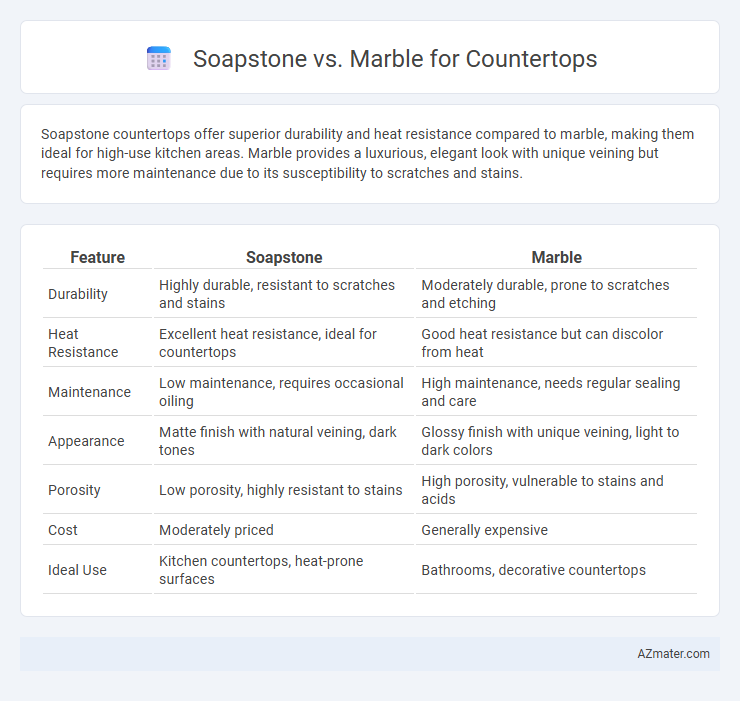Soapstone countertops offer superior durability and heat resistance compared to marble, making them ideal for high-use kitchen areas. Marble provides a luxurious, elegant look with unique veining but requires more maintenance due to its susceptibility to scratches and stains.
Table of Comparison
| Feature | Soapstone | Marble |
|---|---|---|
| Durability | Highly durable, resistant to scratches and stains | Moderately durable, prone to scratches and etching |
| Heat Resistance | Excellent heat resistance, ideal for countertops | Good heat resistance but can discolor from heat |
| Maintenance | Low maintenance, requires occasional oiling | High maintenance, needs regular sealing and care |
| Appearance | Matte finish with natural veining, dark tones | Glossy finish with unique veining, light to dark colors |
| Porosity | Low porosity, highly resistant to stains | High porosity, vulnerable to stains and acids |
| Cost | Moderately priced | Generally expensive |
| Ideal Use | Kitchen countertops, heat-prone surfaces | Bathrooms, decorative countertops |
Understanding Soapstone and Marble Countertops
Soapstone countertops offer exceptional durability and resistance to heat and stains due to their dense composition of talc and other minerals, making them ideal for kitchens with heavy use. Marble countertops, renowned for their unique veining and luxurious appearance, are primarily composed of calcite, which makes them more susceptible to scratches and acid etching compared to soapstone. Understanding the mineral composition and maintenance requirements of soapstone and marble allows homeowners to choose a countertop that balances aesthetics with functionality and longevity.
Appearance and Aesthetic Differences
Soapstone countertops exhibit a smooth, matte texture with deep, rich tones ranging from dark gray to greenish hues, creating a natural, rustic appearance. Marble countertops, known for their polished, glossy finish, feature striking veining patterns in colors such as white, black, and green that provide an elegant, classic look. The subtle, uniform color of soapstone contrasts with the bold, dramatic veining of marble, catering to different aesthetic preferences in kitchen and bathroom design.
Durability and Strength Comparison
Soapstone offers exceptional durability with high resistance to heat, stains, and acids, making it ideal for kitchen countertops subjected to heavy use. Marble, while aesthetically stunning with its natural veining, is softer and more porous, making it more prone to scratches, etching, and staining over time. For strength, soapstone's dense and non-porous nature provides superior longevity compared to marble's more delicate surface, which requires regular sealing and careful maintenance to preserve its appearance.
Maintenance Requirements: Soapstone vs Marble
Soapstone countertops require minimal maintenance due to their natural resistance to stains, heat, and bacteria, needing only occasional oiling to maintain their rich color and surface smoothness. Marble countertops demand more frequent sealing and careful cleaning to prevent etching and staining from acidic substances, making maintenance more intensive and critical to preserving their polished appearance. Choosing between soapstone and marble hinges on balancing soapstone's low-maintenance durability against marble's high-maintenance elegance and sensitivity.
Stain and Heat Resistance
Soapstone countertops exhibit superior stain resistance due to their non-porous surface, making them less prone to absorbing liquids and oils compared to marble. Marble, with its porous nature, is more susceptible to staining from acidic substances, requiring regular sealing to maintain its appearance. Both materials offer excellent heat resistance; however, soapstone's ability to withstand high temperatures without damage or discoloration makes it especially suitable for kitchen environments.
Cost Analysis and Value
Soapstone countertops typically cost between $70 and $120 per square foot, offering strong durability and a unique, matte finish that increases long-term value through low maintenance. Marble ranges from $40 to $100 per square foot but requires frequent sealing and is prone to staining and etching, which can elevate maintenance expenses and reduce resale value. Investing in soapstone provides better cost-efficiency and durability for kitchen surfaces, enhancing home value with fewer upkeep concerns.
Installation Process Overview
Soapstone countertops offer a straightforward installation process due to their softer composition, allowing easier cutting and shaping with standard woodworking tools. Marble, being harder and more brittle, requires specialized equipment and skilled craftsmanship to prevent cracking during fabrication and installation. Proper support and sealing techniques are crucial for marble to ensure durability and resistance to staining after installation.
Best Applications for Each Material
Soapstone excels in kitchens requiring heat resistance and chemical durability, making it ideal for countertops exposed to hot pots and acidic substances. Marble is favored for bathrooms and low-traffic areas where its elegant veining enhances aesthetics despite being more susceptible to scratches and staining. Both materials offer unique benefits tailored to specific environments: soapstone for practical, heavy-use surfaces and marble for decorative, upscale finishes.
Environmental Impact and Sustainability
Soapstone countertops offer a lower environmental impact compared to marble due to their abundant availability and less energy-intensive quarrying process. Marble extraction and processing generate more carbon emissions and waste, contributing to greater ecological degradation. Choosing soapstone supports sustainability through its durability and reduced need for frequent replacement or maintenance.
Making the Right Choice for Your Kitchen
Soapstone countertops offer superior durability and resistance to heat and stains, making them ideal for busy kitchens, while marble provides a classic, elegant aesthetic with unique veining but requires more maintenance due to its porous nature. Homeowners seeking low-maintenance surfaces often prefer soapstone for its longevity and ease of care, whereas marble appeals to those prioritizing timeless beauty and willingness to apply regular sealing and gentle cleaning. Consider factors such as kitchen traffic, maintenance willingness, and desired appearance when choosing between soapstone and marble for a countertop.

Infographic: Soapstone vs Marble for Countertop
 azmater.com
azmater.com